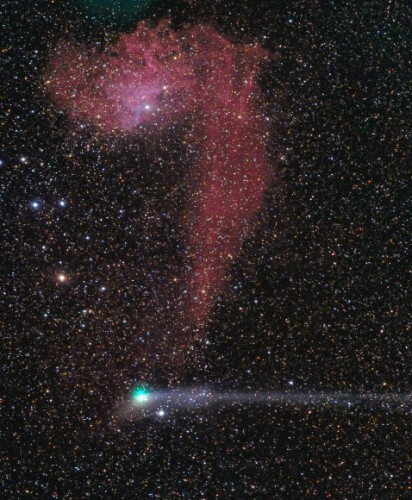A distant nebula and a nearby comet with two tails, this is what is needed to create a one-off astronomical image, yes, and distant professional telescopes available to amateurs from all over the world via the Internet

Bob King, Universe Today
Comet Jacques and the Agalon Group Nebula IC 405, also known as the Burning Star Nebula, aligned and formed a temporary question mark in the sky on the morning of July 26. Photo: Rolando Lagostri
This spectacular image was taken by the Italian amateur astronomer Rolando Lagostri on the morning of July 26 from a remote telescope in New Mexico that has a 106 millimeter diameter reflector.
Comet Jack (C/2014 E2) is a 6.5 magnitude comet that climbs slowly in the morning sky and every day for the past two weeks it has preceded its sunrise into the night and rises higher in the sky.
Yesterday morning it passed by the nebula IC 405 in the constellation Agalon. Together these two bodies formed a heavenly question mark. IC 405, known as the Burning Star Nebula, is a combination of an emitting and a reflecting nebula. Some of the light from the star illuminates grains of cosmic dust, but the deep red color is due to hydrogen excited by strong ultraviolet light coming from that star.
The depth of field in the image is enormous: the nebula is 1,500 light-years away while the comet is about 180 million kilometers away, that is, 75 million times closer. In a rare coincidence, the comet is also illuminated in similar colors. The short dust tail to the left of the nucleus is sunlight reflected from momentary dust grains bubbling out of the nucleus. The large, straight tail consists mainly of carbon monoxide gas that glows in the ultraviolet light coming from the sun.
For the news in Universe Today

One response
One tail, two tails 🙂